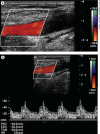Image-Based Evaluation of Vascular Function and Hemodynamics
- PMID: 26587430
- PMCID: PMC4315350
- DOI: 10.1159/000354110
Image-Based Evaluation of Vascular Function and Hemodynamics
Abstract
The noticeable characteristics of the blood vascular structure are the inconsistent viscosity of blood and the stiffness of the vascular wall. If we can control these two factors, we can solve more problems related to hemodynamics and vascular wall function. Understanding the properties of hemodynamics and vascular wall function may provide more information applicable to clinical practice for cardiovascular disease. The bedside techniques evaluating vascular function usually measure indirect parameters. In contrast, some medical imaging techniques provide clear and direct depictions of functional cardiovascular characteristics. In this review, image-based evaluation of hemodynamic and vascular wall functions is discussed from the perspective of blood flow velocity, flow volume, flow pattern, peripheral vascular resistance, intraluminal pressure, vascular wall stress, and wall stiffness.
Keywords: Arterial wall stiffness; Flow velocity; Flow volume; Peripheral vascular resistance; Wall shear stress.
Figures



Similar articles
-
Hemodynamics of human carotid artery bifurcations: computational studies with models reconstructed from magnetic resonance imaging of normal subjects.J Vasc Surg. 1998 Jul;28(1):143-56. doi: 10.1016/s0741-5214(98)70210-1. J Vasc Surg. 1998. PMID: 9685141
-
Arterial wall elasticity: state of the art and future prospects.Diagn Interv Imaging. 2013 May;94(5):561-9. doi: 10.1016/j.diii.2013.01.025. Epub 2013 Apr 22. Diagn Interv Imaging. 2013. PMID: 23619291 Review.
-
Effects of 8-week swimming training on carotid arterial stiffness and hemodynamics in young overweight adults.Biomed Eng Online. 2016 Dec 28;15(Suppl 2):151. doi: 10.1186/s12938-016-0274-y. Biomed Eng Online. 2016. PMID: 28155720 Free PMC article.
-
Development of an Experimental and Digital Cardiovascular Arterial Model for Transient Hemodynamic and Postural Change Studies: "A Preliminary Framework Analysis".Cardiovasc Eng Technol. 2018 Mar;9(1):1-31. doi: 10.1007/s13239-017-0332-z. Epub 2017 Nov 9. Cardiovasc Eng Technol. 2018. PMID: 29124548
-
[Aspects of vascular physiology in clinical and vascular surgical practice: basic principles of vascular mechanics].Zentralbl Chir. 2014 Oct;139(5):499-507. doi: 10.1055/s-0032-1327967. Epub 2013 Jan 16. Zentralbl Chir. 2014. PMID: 23325520 Review. German.
Cited by
-
Influence of renal function and demographic data on intrarenal Doppler ultrasonography.PLoS One. 2019 Aug 27;14(8):e0221244. doi: 10.1371/journal.pone.0221244. eCollection 2019. PLoS One. 2019. PMID: 31454365 Free PMC article.
-
HuangqiGuizhiWuwu Decoction Prevents Vascular Dysfunction in Diabetes via Inhibition of Endothelial Arginase 1.Front Physiol. 2020 Mar 25;11:201. doi: 10.3389/fphys.2020.00201. eCollection 2020. Front Physiol. 2020. PMID: 32269530 Free PMC article.
References
-
- Pfitzner J. Poiseuille and his law. Anaesthesia. 1976;31:273–275. - PubMed
-
- Azelvandre F, Oiknine C. Fahraeus effect and Fahraeus-Lindqvist effect (in French) C R Acad Sci Hebd Seances Acad Sci D. 1977;284:577–580. - PubMed
-
- Chakravarty S, Sen S. Analysis of pulsatile blood flow in constricted bifurcated arteries with vorticity-stream function approach. J Med Eng Technol. 2008;32:10–22. - PubMed
-
- Malek AM, Alper SL, Izumo S. Hemodynamic shear stress and its role in atherosclerosis. JAMA. 1999;282:2035–2042. - PubMed
Publication types
LinkOut - more resources
Full Text Sources
Other Literature Sources

